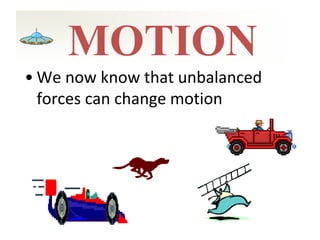
Speed Intro
- 1. MOTION • We now know that unbalanced forces can change motion
- 2. Recognizing Motion Textbook pg 17-18 • When is an object in motion? • Are you or your book moving – Compared to the floor? – Compared to the sun? • What is a reference point? • What do we assume about a reference point? • For the bus example, why do you think you are moving backward?
- 3. Recognizing Motion ANSWERS Textbook pg 17-18 • When is an object in motion? • When it’s distance from another object is changing • Are you or your book moving? – Compared to the floor? NO – Compared to the sun? YES • What is a reference point? • A place or object used for comparison • What do we assume about a reference point? • It is stationary
- 4. Recognizing Motion ANSWERS Textbook pg 17-18 • For the bus example, why do you think you are moving backward? –Your reference point (the other bus) wasn’t stationary You Reference point
- 5. What’s a Frame of Reference?
- 7. NOW WE ARE GOING TO LOOK AT WAYS TO DESCRIBE AND MEASURE MOTION SPEED
- 8. HOW DO WE DESCRIBE SPEED? HOW FAST SOMETHING GOES
- 9. How do we CALCULATE SPEED? • How we describe the speed of a CAR: – Miles per hour (MPH) OR – Kilometers per hour (km/h) • What does the miles or kilometers measure? – They are units for distance • What does the hour measure? – It is a unit for time • What does the “per” or “/” mean in math? – division
- 10. SPEED =RATE that an object moves Distance (D) Rate (speed) = Time (T)
- 11. DISTANCE Length between two places Distance = rate (speed) x time D= RT “Dirt”
- 13. STEPS IN PROBLEM SOLVING STEP 1. Write the formula STEP 2. Substitute given numbers and units STEP 3. Solve for the unknown.
- 14. SAMPLE PROBLEM: At what speed did a plane fly if it traveled 1760 meters in 8 seconds?
- 15. SOLUTION Step 1. Question asked “What speed” so use: Rate (Speed) = Distance/Time
- 16. SOLUTION Step 2. substitute distance = 1760 meters substitute time = 8 seconds Speed = 1760 meters/ 8 seconds
- 17. SOLUTION Step 3. Do the math to get your answer Speed = 220 meters/second (m/sec)
- 18. SAMPLE PROBLEMS: 1. A car travels 240 kilometers in 3 hours. What is the speed of the car during that time? ANSWER: S= d/t S= 240 km/3 hr 80 KM/HR
- 19. The speed of a cruise ship is 50 km/hr. How far will the ship travel in 14 hours? Answer: D = ST 700 km